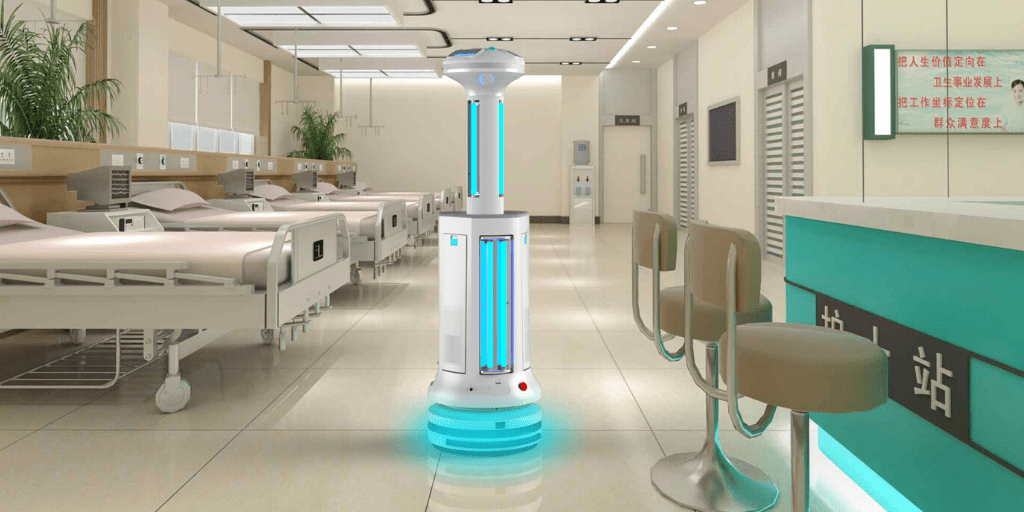‘New normal’ is an expression we hear a lot in the wake of the Coronavirus pandemic. In our day-to-day activities it means being mindful of the ever-present threat of a virus overwhelming our society, but what could be the new normal in healthcare? We have seen mixed reports on how China has dealt with the recent outbreak, in which there seems to be controversy mainly around the early acceptance of the warning. Nevertheless, China is a country with its own challenges, and since the epidemic, it took extraordinary measures in dealing with the outbreak and minimising further impact on its healthcare system. Impressively, a hospital was constructed in a matter of days, for purposes of dealing with Covid-19. Another, lesser known measure, is the use of robotics combined with other technology in achieving tasks necessary in clinical areas. Not only in China. We have seen reports that in Seattle, USA, doctors used a remote-controlled telepresence robot in treating and monitoring a coronavirus patient to minimise risk of infection. In the West, it seems this technology is deployed where appropriate or accessible. However, the use of robotics and artificial intelligence in the far east has been embraced widely as a crucial part of combating the epidemic. Indeed, it seems in the very same areas where population density present a higher risk of epidemic, their measures seemed to have gained more effective control of the spread of Coronavirus.
China has invested in cutting edge innovation in hospitals for infection control, logistical tasks and support in treatment of patients. One such innovation is the ‘Disinfection Robot’. A leading, well renowned technology company in China commissioned and manufactured additional robots to be deployed across the affected regions. So much so, the manufacturer found itself in a position of demand exceeding supply, even providing demonstration models in order to fulfil this demand where they were required for deployment, especially in the area of Wuhan.
Mr Li Maokun, President of Jingzhou Hospital of Traditional Chinese Medicine stated, “in the wake of the coronavirus outbreak, artificial intelligence robotics technology is currently being used in Chinese hospitals, which automates other medical support roles traditionally undertaken by people, in order to further reduce spreading of the virus”.
The robot, which has been developed and produced by the Shanghai TMI Robotics company and distributed in the UK by British based company trading as MedAssyst, moves completely autonomously, fulfilling the task as pre-programmed with the layout and topography of the hospital or department. It will set off systematically disinfecting nearby air and all surfaces in any given area, and even return itself to a docking station when it requires a recharge. It is equipped with 3 disinfection methods: ultraviolet, vaporized chemistry, and air filtration. Any combination of these methods can be applied depending on the space or departmental rooms to be disinfected. The robot automatically calculates disinfection time according to the space and fixings, and ensures no ‘dead spots’. Traditional Ultraviolet Germicidal Irradiation (UVGI) uses short wave ultraviolet light, and has been in wide use as an antimicrobial method for many years across other sectors such as water purification. It works by destroying nucleic acids and disrupting their DNA, leaving them unable to perform vital cellular functions. UV alone, at the optimal distance, can achieve 99.9999% bacterial kill, including antibiotic-resistant bacteria and viruses. When combined with air-filtration, it forms a highly effective method of disinfecting and cleansing the surrounding air, in addition to achieving surface disinfection of surrounding walls, furniture and fixings. The Infection Control Robot also uses a fine mist chemical as a further disinfection method. In cleared/unpopulated spaces this is hydrogen peroxide. On a molecular level, the combination of hydrogen peroxide (H2O2) with UV catalyses the release of hydroxyl radicals (OH), which act effectively against microorganisms via oxidation. In spaces which require public access sooner, a hypochlorous acid solution can be used. This combination of disinfection methods, along with smart technology and robotics, ensures systematic disinfection of any given area, eliminating human factor omissions or errors in traditional disinfection methods by hospital staff. In addition, of course, in minimises human exposure to potentially contaminated areas, ensuring staff safety. The robot is designed to be used and deployed completely autonomously in areas of hospitals or even whole hospitals where infection control is of paramount importance.
Dr Zeng Guang, Chief Scientist of Epidemiology at the Chinese Centre for Disease control and Prevention(CCDC) commented, “It is a good thing that disinfection robots can participate in the epidemic prevention war. It reduces occupational exposure of medical staff in the affected environment, thus saving patients while protecting medical staff.”
When weighed against the real financial cost of hospital acquired infections to healthcare institutions in normal times, and the tragic human impact of infection, as we have seen recently, an automated ‘bot’ which systematically disinfects air and surfaces seems a common sense approach, even in the absence of an epidemic crisis.
In fact, this particular robot has even been deployed in government and public buildings. Having recently been used in Hong Kong Airport. The applications of the infection control robotics are vast, and go far beyond healthcare facilities. Obvious applications are care homes, prisons and military facilities.
MedAssyst are welcoming interested hospitals and other parties to partake in early pre-launch trials in the UK as a partnership to help drive and refine the applications of this technology in UK healthcare institutions. All as part of a wider objective of keeping the coronavirus as contained as possible. Interested persons can contact MedAssyst directly at enquiries@medassyst.com .












